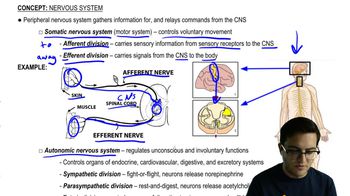Table of contents
- 1. Introduction to Biology2h 42m
- 2. Chemistry3h 37m
- 3. Water1h 26m
- 4. Biomolecules2h 23m
- 5. Cell Components2h 26m
- 6. The Membrane2h 31m
- 7. Energy and Metabolism2h 0m
- 8. Respiration2h 40m
- 9. Photosynthesis2h 49m
- 10. Cell Signaling59m
- 11. Cell Division2h 47m
- 12. Meiosis2h 0m
- 13. Mendelian Genetics4h 44m
- Introduction to Mendel's Experiments7m
- Genotype vs. Phenotype17m
- Punnett Squares13m
- Mendel's Experiments26m
- Mendel's Laws18m
- Monohybrid Crosses19m
- Test Crosses14m
- Dihybrid Crosses20m
- Punnett Square Probability26m
- Incomplete Dominance vs. Codominance20m
- Epistasis7m
- Non-Mendelian Genetics12m
- Pedigrees6m
- Autosomal Inheritance21m
- Sex-Linked Inheritance43m
- X-Inactivation9m
- 14. DNA Synthesis2h 27m
- 15. Gene Expression3h 6m
- 16. Regulation of Expression3h 31m
- Introduction to Regulation of Gene Expression13m
- Prokaryotic Gene Regulation via Operons27m
- The Lac Operon21m
- Glucose's Impact on Lac Operon25m
- The Trp Operon20m
- Review of the Lac Operon & Trp Operon11m
- Introduction to Eukaryotic Gene Regulation9m
- Eukaryotic Chromatin Modifications16m
- Eukaryotic Transcriptional Control22m
- Eukaryotic Post-Transcriptional Regulation28m
- Eukaryotic Post-Translational Regulation13m
- 17. Viruses37m
- 18. Biotechnology2h 58m
- 19. Genomics17m
- 20. Development1h 5m
- 21. Evolution3h 1m
- 22. Evolution of Populations3h 53m
- 23. Speciation1h 37m
- 24. History of Life on Earth2h 6m
- 25. Phylogeny2h 31m
- 26. Prokaryotes4h 59m
- 27. Protists1h 12m
- 28. Plants1h 22m
- 29. Fungi36m
- 30. Overview of Animals34m
- 31. Invertebrates1h 2m
- 32. Vertebrates50m
- 33. Plant Anatomy1h 3m
- 34. Vascular Plant Transport1h 2m
- 35. Soil37m
- 36. Plant Reproduction47m
- 37. Plant Sensation and Response1h 9m
- 38. Animal Form and Function1h 19m
- 39. Digestive System1h 10m
- 40. Circulatory System1h 49m
- 41. Immune System1h 12m
- 42. Osmoregulation and Excretion50m
- 43. Endocrine System1h 4m
- 44. Animal Reproduction1h 2m
- 45. Nervous System1h 55m
- 46. Sensory Systems46m
- 47. Muscle Systems23m
- 48. Ecology3h 11m
- Introduction to Ecology20m
- Biogeography14m
- Earth's Climate Patterns50m
- Introduction to Terrestrial Biomes10m
- Terrestrial Biomes: Near Equator13m
- Terrestrial Biomes: Temperate Regions10m
- Terrestrial Biomes: Northern Regions15m
- Introduction to Aquatic Biomes27m
- Freshwater Aquatic Biomes14m
- Marine Aquatic Biomes13m
- 49. Animal Behavior28m
- 50. Population Ecology3h 41m
- Introduction to Population Ecology28m
- Population Sampling Methods23m
- Life History12m
- Population Demography17m
- Factors Limiting Population Growth14m
- Introduction to Population Growth Models22m
- Linear Population Growth6m
- Exponential Population Growth29m
- Logistic Population Growth32m
- r/K Selection10m
- The Human Population22m
- 51. Community Ecology2h 46m
- Introduction to Community Ecology2m
- Introduction to Community Interactions9m
- Community Interactions: Competition (-/-)38m
- Community Interactions: Exploitation (+/-)23m
- Community Interactions: Mutualism (+/+) & Commensalism (+/0)9m
- Community Structure35m
- Community Dynamics26m
- Geographic Impact on Communities21m
- 52. Ecosystems2h 36m
- 53. Conservation Biology24m
47. Muscle Systems
Musculoskeletal System
Problem 1
Textbook Question
Which of the following statements regarding control of muscle tissue is/are correct? Select True or False for each statement.
T/F All skeletal muscles are voluntary.
T/F Cardiac muscle is involuntary.
T/F Some smooth muscle tissues are voluntary, and others are involuntary.
T/F Parasympathetic and sympathetic neurons innervate skeletal, cardiac, and smooth muscle tissues.
 Verified step by step guidance
Verified step by step guidance1
Understand the types of muscle tissues: Skeletal, Cardiac, and Smooth. Skeletal muscles are generally under voluntary control, meaning you can consciously control their movement.
Cardiac muscle is found in the heart and is involuntary, meaning it functions without conscious control. It is regulated by the autonomic nervous system.
Smooth muscle is found in various parts of the body such as the walls of blood vessels and the digestive tract. It is generally involuntary, but some smooth muscles can be controlled voluntarily, such as those in the urinary bladder.
The autonomic nervous system, which includes parasympathetic and sympathetic neurons, primarily innervates cardiac and smooth muscle tissues, not skeletal muscles. Skeletal muscles are innervated by the somatic nervous system.
Evaluate each statement based on the understanding of muscle control: Skeletal muscles are voluntary, cardiac muscles are involuntary, smooth muscles can be both, and autonomic neurons do not innervate skeletal muscles.
 Verified video answer for a similar problem:
Verified video answer for a similar problem:This video solution was recommended by our tutors as helpful for the problem above
Video duration:
1mPlay a video:
Was this helpful?
Key Concepts
Here are the essential concepts you must grasp in order to answer the question correctly.
Voluntary vs. Involuntary Muscle Control
Muscle control is categorized into voluntary and involuntary types. Voluntary muscles, like skeletal muscles, are consciously controlled, allowing movements such as walking. Involuntary muscles, such as cardiac and most smooth muscles, operate without conscious control, managing functions like heartbeats and digestion.
Recommended video:
Guided course

Specific Transcription Factors
Types of Muscle Tissue
There are three main types of muscle tissue: skeletal, cardiac, and smooth. Skeletal muscles are attached to bones and facilitate movement. Cardiac muscle is found in the heart and is responsible for pumping blood. Smooth muscle is located in walls of hollow organs and helps in processes like peristalsis in the digestive tract.
Recommended video:
Guided course

Muscle and Epithelial Tissues
Autonomic Nervous System
The autonomic nervous system (ANS) regulates involuntary physiological functions and is divided into sympathetic and parasympathetic systems. It innervates cardiac and smooth muscles, controlling heart rate, digestion, and other automatic functions. Skeletal muscles are primarily controlled by the somatic nervous system, not the ANS.
Recommended video:
Guided course

Peripheral Nervous System

 2:08m
2:08mWatch next
Master Muscle System and Skeleton with a bite sized video explanation from Jason
Start learningRelated Videos
Related Practice
Multiple Choice
Why is having a hydrostatic skeleton rather than an internal skeleton advantageous to an earthworm?
1112
views
